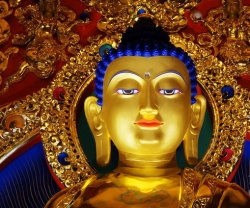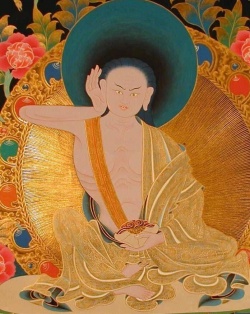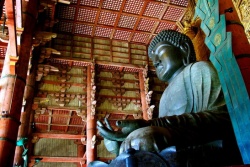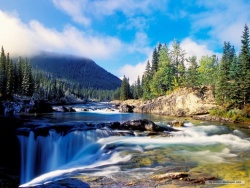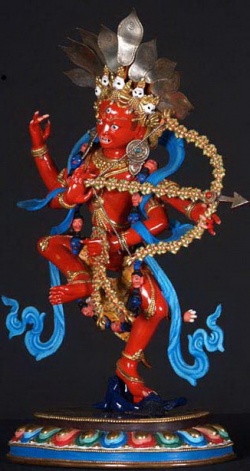Shambhala - The Magic Kingdom
'May I quickly take birth in Shambhala, the treasury of jewels,
And complete the stages of the path in Highest Yoga Tantra.'
From 'The Guru Yoga of Kalachakra' by Ling Rinpoche
WHAT IS SHAMBHALA?
Shambhala or "bde 'byung" in Tibetan, means "The source of happiness".
The Kingdom of Shambhala takes a central place in the Kalachakra teachings. Not only did the historical Shakyamuni Buddha teach the Kalachakra tantra at the request of King Suchandra of Shambhala, also the teachings are said to be preserved there. It is predicted that a few centuries from now, a spiritual revival of the world will come from Shambhala.
As can be seen on the image below on the right, Shambhala is usually depicted as circular. Divided like a Dharma-Wheel, it spreads out between high mountains and contains many cities. In the center of the hub is the capital Kalapa.
Several people, including the ones who brought the Kalachakra teachings into our world, are said to have traveled there, or have had visions of it. One of the visionaries alive these days is Khamtrul Rinpoche. A brief account of his vision can be found on the website of Kalachakra.com, look for 'Shambhala' and 'Vision'.
As His Holiness the Dalai Lama noted during the 1985 Kalachakra initiation in Bodhgaya, Shambhala is not an ordinary country:
"Although those with special affiliation may actually be able to go there through their karmic connection, nevertheless it is not a physical place that we can actually find. We can only say that it is a pure land, a pure land in the human realm. And unless one has the merit and the actual karmic association, one cannot actually arrive there."
To the south of the Town of Kalapa (capital of Shambhala) is the Sandalwood Park, twelve yojanas across, same as the town of Kalapa. To its east is Lesser Manasa Lake, twelve yojanas across, and to the west is White Lotus Lake, of the same extent. In between these two is Sandalwood Park. In the center of Sandalwood Park is the great Kalachakra Mandala built by King Suchandra (first king of Shambhala), consisting of the gods and goddesses made out of the five jewels, square, four hundred hastas across. [2] {From the Vimalaprabha)
We can talk about 3 Shambhalas. 'Outer Shambhala' exists as a kingdom in the external world, the 'Inner Shambhala' lies hidden in the body and mind, and the 'Other Shambhala' is the Kalachakra mandala with all its deities.
The outer journey to Shambhala bears close relation to the advanced Completion Stage practice of Kalachakra, the physical obstacles on the way represent inner barriers that must be faced at the psychic centers. These barriers form the knots that block the proper energy flow through the psychic nervous system; as such, they correspond to mental defilements, such as ignorance and lust, that limit our awareness.
Working one's way through the chakras until one has opened them all and liberated the innermost mind from its imprisonment in the last reached - the heart center
In taking the inner journey to Shambhala, we strive to regain this direct awareness of a child with all its sense of wonder and awe. But we cannot do so by retreating in the past and attempting to become children again. We have lost the innocence that enabled us to experience the world directly.
We cannot simply ignore or wish away the screen of preconceptions that now obscures our vision. We have to face ourselves and see what we have done to our minds. Only by becoming aware of our illusions and how we cling to them can we free ourselves from their power and awaken a fresh and direct awareness of the world around us. Rather than to go back, we have to go forward to a new and wiser innocence - one that combines the wonder of a child with the wisdom of a sage. By treating the ordinary events of daily life as we did the magical features of the journey to Shambhala, we may be able to uncover the hidden aspects of ourselves that we need to know in order to awaken the deeper mind.We can even see the history and prophecy of Shambhala as an allegory for the course of life as a whole. As an initiation, the Buddha's teaching of the Kalachakra in India symbolizes the birth of a baby with his fresh, new vision of reality.
The loss of true religion in the outside world represents the child's loss of awareness and spontaneity as he grows up in a society that encourages him to ignore his inner nature and be false to himself. Just as the barbarian doctrines take over the world, so the values and concerns of others take over his mind, filling it with conflicting desires and illusions. He reaches the stage symbolized by the wars that the victorious barbarians fight amongst themselves. Most people never go beyond this stage; they remain caught in the conflicts of the surface consciousness, unable to get what they want or see themselves as they are. Those who achieve worldly success ... reach the stage of the King who unites all the squabbling barbarians under his dictatorial rule. The final battle and the golden age .. represent the real fulfillment of life - the attainment of true maturity.
This myth [of constant improvement], which has driven us for so long, is now, however, reaching its limits. Even those who seem to have benefited, those who live in the affluent suburbs or other oases of prosperity, are experiencing a growing sense of boredom and meaninglessness that drives many of them to random acts of violence and self-destruction. The myth of progress seems, in fact, to have led us into the degenerate period of materialism that is supposed to precede the golden age of Shambhala.
NOTES ON THE SYMBOLISM OF SHAMBHALA }
96 Principalities with Millions of Towns refer to our network of nadis (energy channels in the body.
Inhabitants refer to the energy (wind) in nadis.
Outer Ring of Snow Mountains refer to the skin
Inner Ring of Snow Mountains refer to the central channel
Two Lakes refer to the side channels.
Wealth of All Inhabitants, refers to the treasures of the mind.
Inner Shambhala can be identified with the heart chakra, the innermost [subtlest] mind lies here.
8-Petalled Shape of the Regions of Shambhala stand for the 8 nadis from the heart center, each serves one of the 8 kinds of consciousness through which we experience ourselves and the world. The 5 senses, the consciousness, of self or ego, the consciousness of thoughts and the store consciousness of past impressions. Texts describe Shambhala in the form of an 8 petalled lotus so that yogis can visualize it as a mandala in their hearts [Dardo Rinpoche).
Bright Light from the Palace turning night into day refers to the bright, clear awareness that dispels the darkness of ignorance and illusion.
Sky-Lights in the King's Palace fitted with lenses giving view of life on distant stars and planets, refers to the great range and extent of the clear light awareness
Magic Screen of the King permitting to observe everything closer by refers to clairvoyant powers of the innermost mind.
Golden Throne of the King with 8 Lions refers to the underlying power and steadiness of the innermost mind.
Wishfulfilling Gem refers to the power of the innermost mind to liberate itself.
Magic Rods, the "Possessors of the Power of Mind" which the 96 lesser Kings have, (which enables them to send messages to wherever they wish in an instant - mobile phones!) refers to the efficient communication and control the deepest levels of mind can have over body and consciousness.
Lakes symbolize the fruits of spiritual practice; the lake Padma Karpo "White Lotus", implies it reflects the pure awareness of the innermost mind.
Malaya Park or "Cool Grove" refers to the cool and refreshing awareness of reality, extinguishing the painful fires of desires and illusion.
Peace and Harmony refers to the people of Shambhala being no longer subject to inner conflicts and turmoil.
Gentle Laws and No Hard Punishment refers to people reaching this stage are beyond the need of harsh (self) discipline.
Subdued Demons, the inhabitants have subdued demons and made them to servants refers to taming the wilder impulses and using them for reaching the goal.
No Loss of Virtue when inhabitants enjoy wealth and comfort refers to being beyond attachment which would hold them back from enlightenment.
Great Distance (of Shambhala) refers to the far mysterious reaches of unconscious mind.
